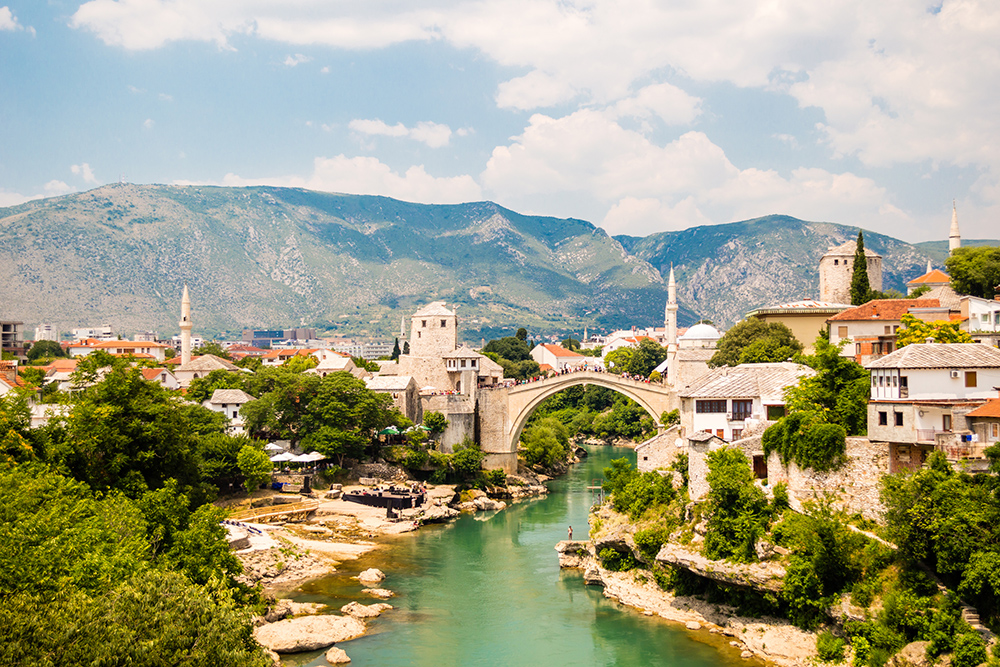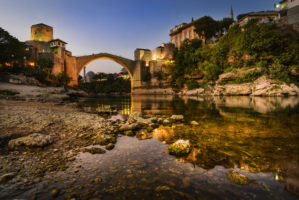
By Julia Zaremba
Two sides of the river, both alike in dignity. For thousands of years, Mostar has been divided between cultures, religions and political powers. At the same time, it has been connected by more than just Stari Most, a UNESCO bridge that bridges the Neretva River. Churches, mosques and synagogues exist side-by-side, and it is this juxtaposition of civilizations that gives this Balkan city its colorful charm.
The most important city in the Herzegovina region, Mostar is quick to win anyone’s heart. Where else can travelers lounge in cliff-side cafes, indulging on fresh burek, listening to a melodious adhan floating from minarets at the same time as church bells chime? The hustle-and-bustle of Oriental bazaars, with their Aladdin lamps and Persian rugs, are reminiscent of Eastern lands, but the Adriatic Sea is a mere 50 km away. Looming over all of this is the iconic Old Bridge, which has been linking cultures for more than four centuries.
Ottoman emperor Sultan Suleiman the Magnificent ordered construction of the bridge in 1557. The task took nine years to complete, the result being the widest man-made arch of the time. Solomon threatened to execute the architect if the bridge collapsed; a fate not uncommon to the previous seven bridges built in the area. On the day that the support stakes were taken out, Hayruddin, the Turkish engineer, put on is death suit. However, success ensued and it wasn’t until 1993 that the bridge was destroyed by Croat bombs.
Years of cultural coexistence came to an abrupt stop in 1992, when the Bosnian War broke out. The dominant question was whether Bosnia should remain in the Yugoslav Republic or become an independent country, and contrasting opinions took their toll on the city and its inhabitants.
The Western part of the river was ruled by Croat forces, and the Eastern side housed the Army of the Republic of Bosnia and Herzegovina. After the Croatian Defence Council led a particularly heavy attack in May of 1993, control of access to the city fell into the hands of Croatian nationalists. The area became off-limits to international organizations, and the next three years saw the highest number of attacks in the country.
While a new bridge was erected in 2004, the past is still very much visible in the present. Bullet holes decorate buildings, dilapidated constructions mingle with the modern, and old mentalities prevail. Croat and Bosnian school kids enroll in separate classes, each with their own textbooks. Both sides of the river has its own phone network, postal system, and utility services.
The passage of time and increase of tourism in the area has brought Mostar back into peaceful times and at the top of a true backpacker’s travel list. With history still so fresh, the connection to the town and conversations with its inhabitants carry a sense of fragile intimacy not found in the crowded, dusty ruins of the Colosseum or the Parthenon.
The food is fresh and delicious, the prices are cheap, the handicrafts are colorful, the coffee is strong and the people are enthusiastic to help and share. Many hostels are found in family buildings, making the travel experience feel more like a visit to a long-long friend than a solo trip to a foreign country. Chatting over freshly-brewed Turkish coffee and nibbling on Turkish delights is common, conversations lasting long into the night.
For those that love a good dose of adrenaline, there’s also the option of partaking in traditional feats of glory. With records dating back to 1664, a seal of manhood is awarded upon diving 24 meters off Stari Most, into the freezing waters below. However, these days, not only 16-year-old boys wanting to prove their worth and impress girls jump off this bridge. Hordes of daring backpackers launch themselves off the Mostar Bridge, gaining 80 km/h momentum in the three-second drop. Jumping costs 25 Euros, but successful attempts results in an entry in the Mostari diving club book and free lifetime diving privileges.
This way, there’s reason to come back and impress, just like Mostar keeps impressing. It’s probably not an accident that this country is shaped like a heart and that Mostar’s tourism sector is growing rapidly. Come ready to fall in love with contrasts, try new flavors and stand on one of the most significant Islamic architectural pieces in the Balkans. From this perspective, it’s easy to see the importance of coexistence in moving forward.
ABOUT THE AUTHOR:
Julia is an artist, avid traveler, theater geek, future bestselling author, and language teacher. Born in Germany to a Polish family, she grew up in Texas and has spent the last six years living out of her suitcase. Most of her travels revolve around Europe and the Americas, chasing the next adventure. Follow her @jgzaremba.
Featured image via Shutterstock
